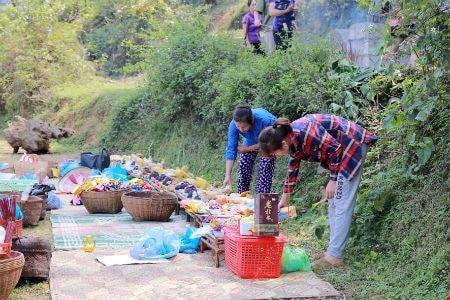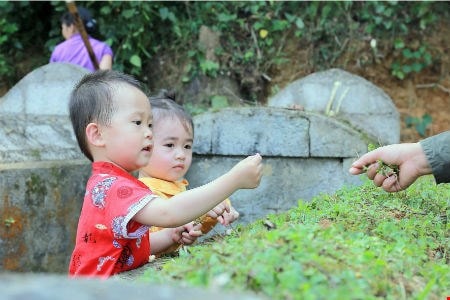Unique custom of repairing the underworld house of the Tay people
According to the customs of Vietnamese people in general and Tay people in Binh Lieu district (Quang Ninh) in particular, every year on the 3rd day of the 3rd lunar month, no matter where they are, they try to return to their hometown to visit the graves with their family.
Unique custom of repairing the underworld house of the Tay people in Binh Lieu
This is an opportunity for descendants to take care of graves, show gratitude and respect to their ancestors, a cultural beauty that the Tay people have respected and preserved for generations.
The house of Mrs. Be Thi Hoa (in Binh Quan area, Binh Lieu town) became crowded today. As soon as it was early in the morning, she and her daughter-in-law and granddaughter-in-law were busy preparing the offerings. Each person had a task: one was butchering chicken, another was cooking sticky rice, another was frying fish…
 |
| In the billowing smoke of incense, descendants will visit their ancestors' graves. |
Ms. Hoa said: “The offerings on the grave-sweeping day of the Tay people usually include sticky rice, chicken, pork, fried fish, wine, votive paper money, incense, and families with good conditions will also have pig’s head… Sticky rice here is often cooked in many eye-catching colors, usually including 5 main colors: white, red, blue, purple, yellow. In addition to white, which is the natural color of rice, the colors blue, red, purple, and yellow are all made from roots and leaves of forest trees.
In which, red symbolizes desire, purple symbolizes the richness of heaven and earth, yellow symbolizes abundance, green symbolizes the mountains and forests of Binh Lieu, white symbolizes pure love and loyalty. All have symbolic meanings of yin and yang and the five elements. Depending on each family, there is a different way to combine colors, some families use 5 colors, some only 2 colors, or 3 colors.
Offering trays are displayed by descendants below the graves.
After the offerings were prepared, the elders would lead the group, followed by the children and grandchildren, to the graves of their grandparents and ancestors. The rain had just stopped, and in the morning sunlight of the Qingming festival, following Mrs. Hoa and her family, we arrived at the Tea Hill Cemetery, where the graves of the deceased were filled with incense smoke and various offerings. In the billowing incense smoke, some people held hoes, some held shovels, some held knives, each doing their own thing.
 |
| Offering trays are displayed by descendants below the graves. |
The elderly were busy burning incense on all the graves, mumbling prayers. The middle-aged and young people were clearing weeds and wild plants growing over the graves, as well as preventing wild animals like snakes and rats from digging holes and making nests. They were repairing the places worn down by the rain. Others were digging soil to fill the graves.
After the work of clearing, cleaning and filling the grave is done, the homeowner will place two red papers diagonally in the center of the grave and fill a new square of soil on top, and place four red or pink flagpoles in the four corners of the grave (the flag of the underworld means that this is an area that cannot be encroached upon and has been cleaned) on the grave. Finally, they light incense and burn votive paper to invite the deceased to celebrate Tet together. The work continues like that until the last grave of the family, relatives will clean up the offerings and sit down to eat happily together.
Ms. Hoa said: “The Tay people believe that when incense and votive paper are burned, it means that the deceased has received all the offerings that the living want to send. When a white flag is raised on the grave, relatives can set out a tray of food and drink or collect blessings to bring home. The cleaner the grave is, the higher and bigger the soil is, the happier the ancestors will be. The more one does, the more blessings they will receive from their grandparents and ancestors that year.”
Taking children to visit graves is to educate the younger generation to respect their ancestors.
During these days, children also follow their parents and grandparents to visit the graves, first to gradually learn about the graves of their ancestors, and then to teach the younger generation to respect their ancestors through the custom of visiting graves. La Thi Lan Anh (4 years old) also followed her mother to burn incense and weed her grandfather's grave. Lan Anh said: "This is my grandfather's grave. He passed away and couldn't weed. I helped him weed so his grave would be clean."
People who work far away from home all year round often return on this occasion to visit graves and reunite with family and relatives. The Tay people believe that they may not be able to return home for Tet but they cannot be absent on the day of the tomb-sweeping festival. This year's tomb-sweeping festival is no exception, in Binh Lieu, people everywhere go to visit graves.
Ms. La Thi Sin, working in Mong Cai, said: "Every year, when the 3rd day of the 3rd lunar month approaches, I try to arrange my work to return to my hometown to clean and repair the graves of my grandparents and ancestors."
Besides the graves that are carefully and meticulously cared for, there are also ownerless graves with no visitors (possibly the graves of the Chinese in the past). People who visit these graves often also burn incense at these graves.
 |
| Taking children to visit graves is to educate the younger generation to respect their ancestors. |
According to our research, the tomb sweeping also takes place according to the family line. However, the time for sweeping the tombs can take place earlier or on holidays, each family will send a representative to sweep the common ancestral graves, branch graves to show the morality and duty of descendants to remember the merits of their ancestors, of their deceased ancestors, reminding descendants to remember their homeland and roots.
Near the end of the day, the overgrown graves were swept clean, along the cemetery, the hillsides, all over the graves were lit up with a red flagpole signaling the completion of the “graves” of the ancestors. On the faces of each person, mixed with drops of sweat, were joy, smiles, and happiness at being able to show their gratitude to their ancestors.
It can be said that the Tay people's tomb-sweeping festival in Binh Lieu is closely associated with the morality of "When drinking water, remember its source", "When eating fruit, remember the person who planted the tree", "Respect for ancestors", this is also an occasion for descendants to return to their homeland, their ancestral land, put aside all worries, contribute to educating the next generation on humane behavior, preserving and promoting national identity on the basis of cultural flow.
According to Vietnamese Law
| RELATED NEWS |
|---|
